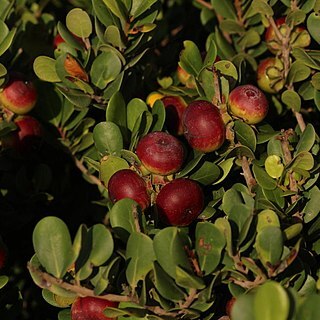A small to medium-sized tree with wide-spreading branches, 2-9 m in height. Bark: dark brownish black; branchlets with reddish hairs when young, becoming grey. Leaves: spirally arranged, erect, obovate to almost circular, 2-6 x 2-6 cm, thickly leathery, glossy olive-green to grey-green above, paler green, hairless below, with about 5 pairs of indistinct lateral veins; apex rounded, often notched; base broadly tapering to square; margin entire, often rolled under; petiole up to 5 mm long. Flowers: creamy white, up to 8 x 8 mm, axillary, solitary (Oct./Nov.). Fruit: ovoid, fleshy, up to 2.5 x 1.5 cm, sticky when young, smooth, glossy red to purplish, persistent calyx forming a rimmed cup with 4 or 5 wing-like lobes up to 2.5 cm long, curling backwards to resemble a frill (Apr.-Sept.).
An erect evergreen shrub or tree. It grows 4-11 m high. The trunk and branches are angular. It forms branches low down and they are wide spreading. The bark is smooth and dark brown. The flowers are white. They are small and 8 mm long and bell shaped. They occur singly in the axils of the leaves. The fruit is an oval berry. It is sticky when young and red when ripe.
Leaves coriaceous, drying pale brown or greenish–brown; lamina 3 x 2·6–4·5 x 3·8 cm., suborbicular or orbicular, apex broadly rounded to subtruncate, margin recurved; lower surface glabrous; lateral nerves in c. 5 pairs, indistinct.
Calyx 0·9–1·2 cm. long, glabrous; tube cup–shaped, very thick and fleshy, contrasting with the wide, strongly venose, membranous marginal frill which forms (4) 5 plicate lobes alternating with (4) 5 decurrent sinuses.
Corolla 1·2–1·5 cm. long, hypocrateriform, widely open at the throat, glabrous; tube 0·6–0·8 x 0·4–0·5 cm., much shorter than the calyx; lobes (4) 5–6, 0·5–0·7 x 0·5–0·7 cm., spreading, suborbicular.
Corolla 0·9–1·3 cm. long, campanulate; tube much longer than the calyx, 0·6 x 0·4–0·7 x 0·5 cm., widely open at the throat; lobes 4–6, up to 0·6 x 0·45 cm., broadly Ungulate, spreading.
Fruiting calyx scarcely accrescent but becoming flattened and patelliform as the fruit matures, lobes c. 0·8 cm. long.
Female flowers solitary in leaf–axils and in axils of fallen leaves; pedicels c. 0·3 cm. long.
Male flowers solitary in leaf–axils and in axils of fallen leaves; pedicels 0·3–0·6 cm. long.
Evergreen shrub or rigidly branched tree with wide–spreading branches, 2–8 (11) m. tall.
Staminodes c. 15, c. 0·4 cm. long, attached to base of corolla–tube, glabrous.
Ovary 0·3 x 0·3 cm., glabrous; styles (4) 5, 0·275 cm. long; locules (8) 10.
Seeds 8 or 10 or fewer by abortion, 1–5 x 0–8 x 0–3 cm., very dark brown.
Stamens c. 30, 0·3–0·4 cm. long, glabrous; filaments c. 0·1 cm. long.
Calyx 0·3–0·5 cm. long, minutely puberulous outside.
Fruit c. 2·5 x 2·5 cm., glabrous, globose.

